Latest Event Updates
Meet our Social Media Coordinator, Allison Crutchfield!
Howdy! My name is Allison Crutchfield. I currently live in Oklahoma, where I work full-time at a public library. I am a first year MLIS student at UB and hope to be a public librarian in the future. I particularly enjoy YA/New Adult literature, but am enjoying children’s lit and services this semester! Outside of grad school, I love to make art, go to concerts, read, and post about the books I’ve read to social media.
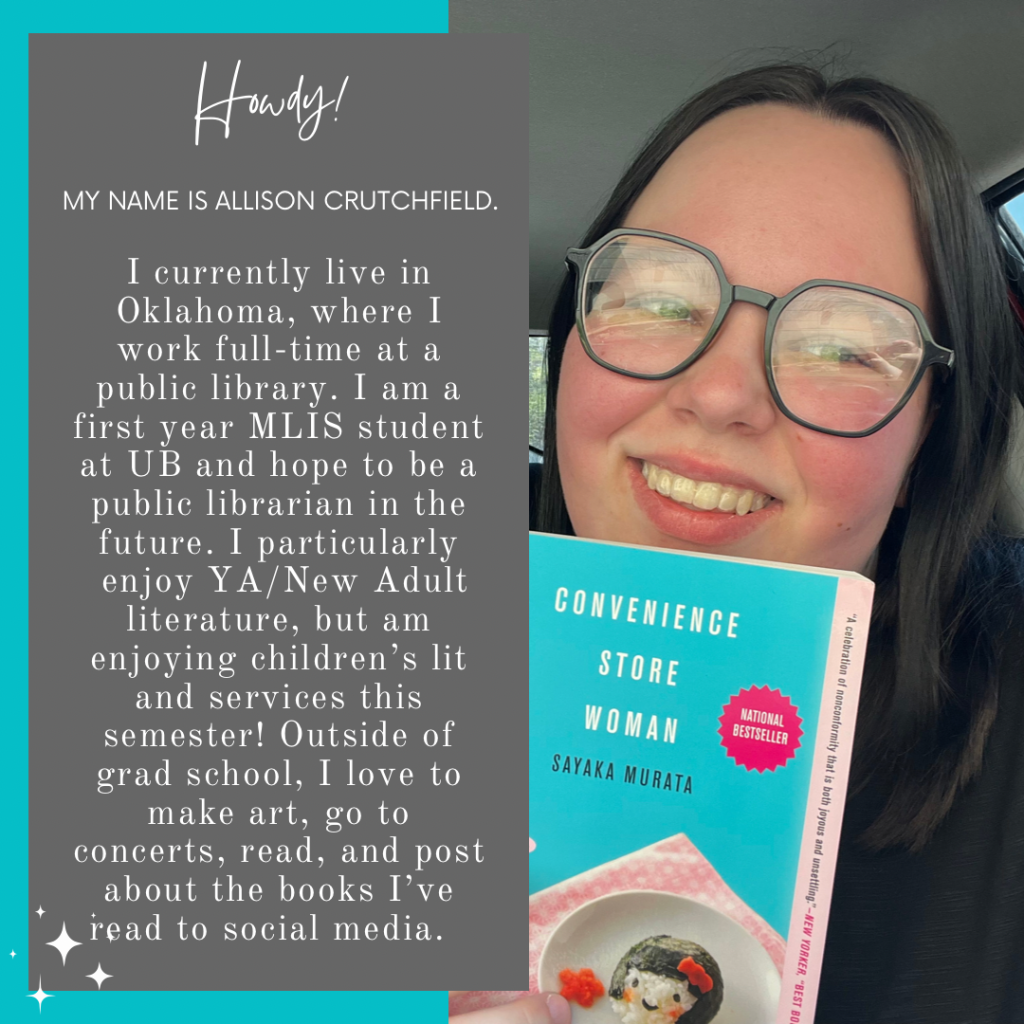
It’s time to meet our Vice President!
My name is Christina L’Hommedieu and I am located here in Buffalo just a few miles from UB north campus. This is the beginning of my 3rd year in the MLIS program, and I have recently switched from the public librarianship side to the school librarianship program. I have always dreamed of becoming a youth librarian and through the years I hope to work both in a school and public library. Currently, I am a regular volunteer at my local branch working with tweens and teens on a newsletter program. Also, this is also my second year being involved in the student ALA here at UB. On the personal side of things, I enjoy reading tons of middle-grade and YA literature, riding my bike, and spending time (aka surviving) with my 3 kiddos. Please reach out and connect anytime!
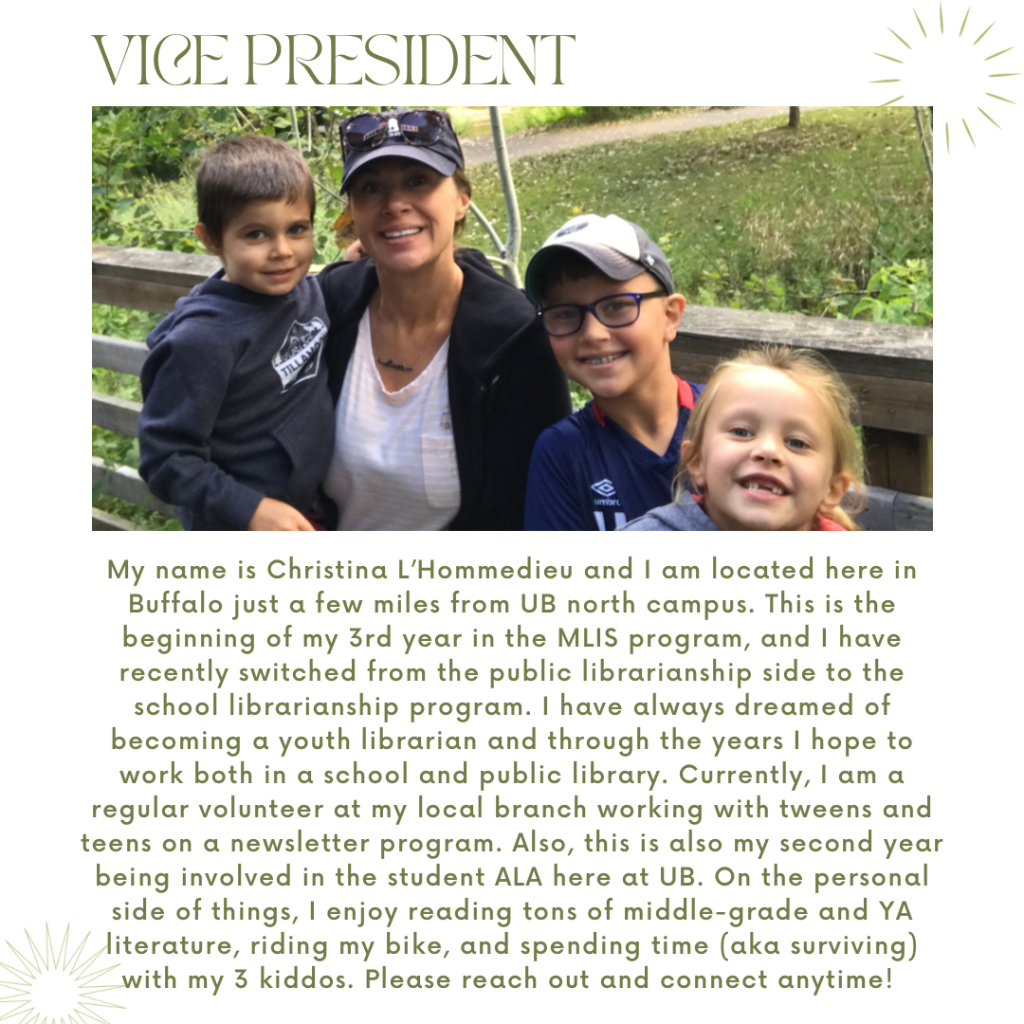
Kickoff Meeting Notes 9/12/2022
If you missed our first meeting of the semester, or would like a refresher, here are our meeting notes!
Meet our President, Marisa Hadley!
“Hello everyone! My name is Marisa Hadley, I’m a second year Information and Library Science graduate student, and I am honored to serve as this year’s Student ALA President. I currently live in Boise Idaho with my husband, our cat named Squirrel, and our one-year-old Bulldogge named Nessie (i.e. the Loch Ness Monster). In my free time I enjoy playing video games, watching trivia TV, and browsing real estate apps. Post-graduation, I hope to work as a makerspace or technology librarian.”
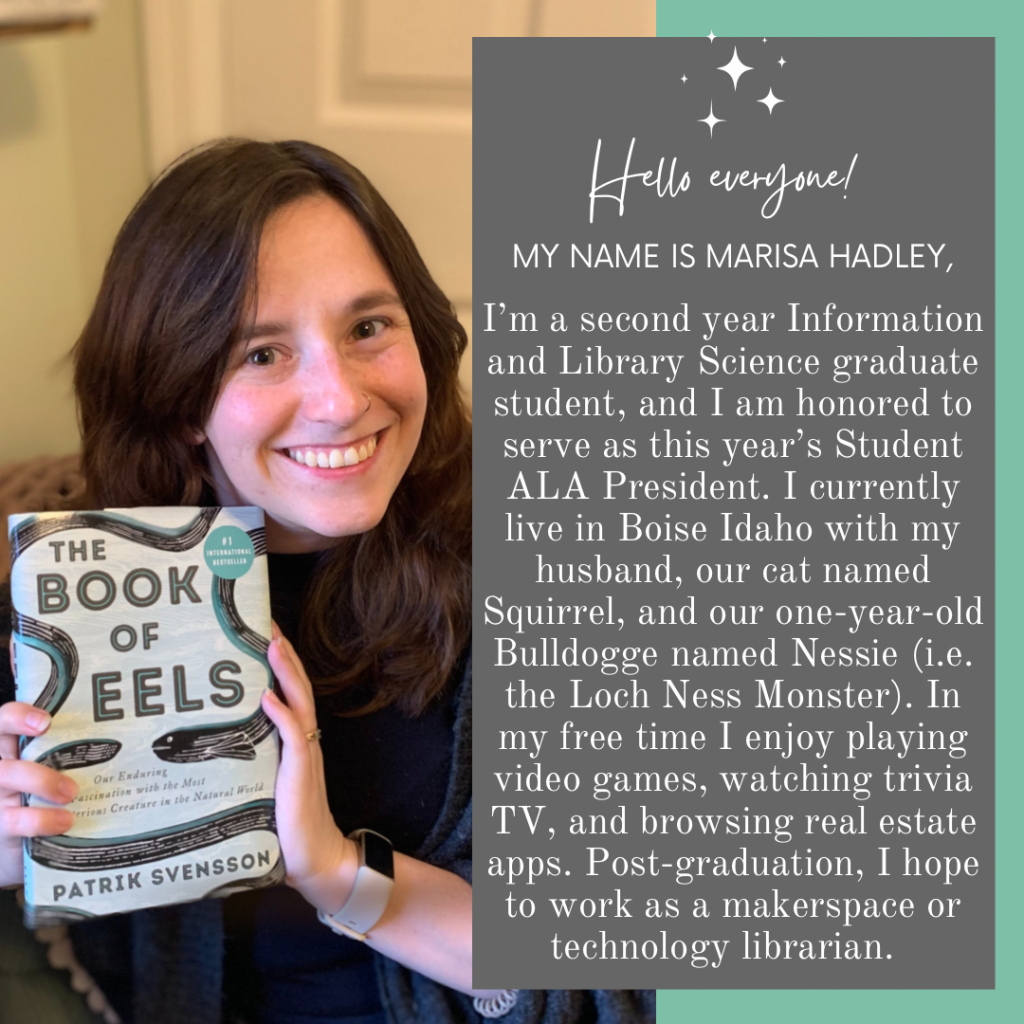
Welcome back new and returning Student ALA members – A Message From Our President
We hope you had a restful summer and are ready to jump right into another fulfilling year!
For those who don’t know who we are, we are University at Buffalo’s American Library Association (ALA) Student Chapter, which is a student-led organization aimed at supporting fellow Information and Library Science graduate students through professional development events and community-based learning. If you are interested in getting involved, please do not hesitate to reach out to us via our shared Student ALA e-mail (ubstudentala@gmail.com) or to me personally – I’m always happy to meet future colleagues! You can also keep up to date on upcoming chapter meetings, workshops, or events by following us on LinkedIn or Instagram. Looking forward to another year of learning alongside you all!
Best,
Marisa Hadley, 2022/2023 UB Student ALA President
mchadley@buffalo.edu
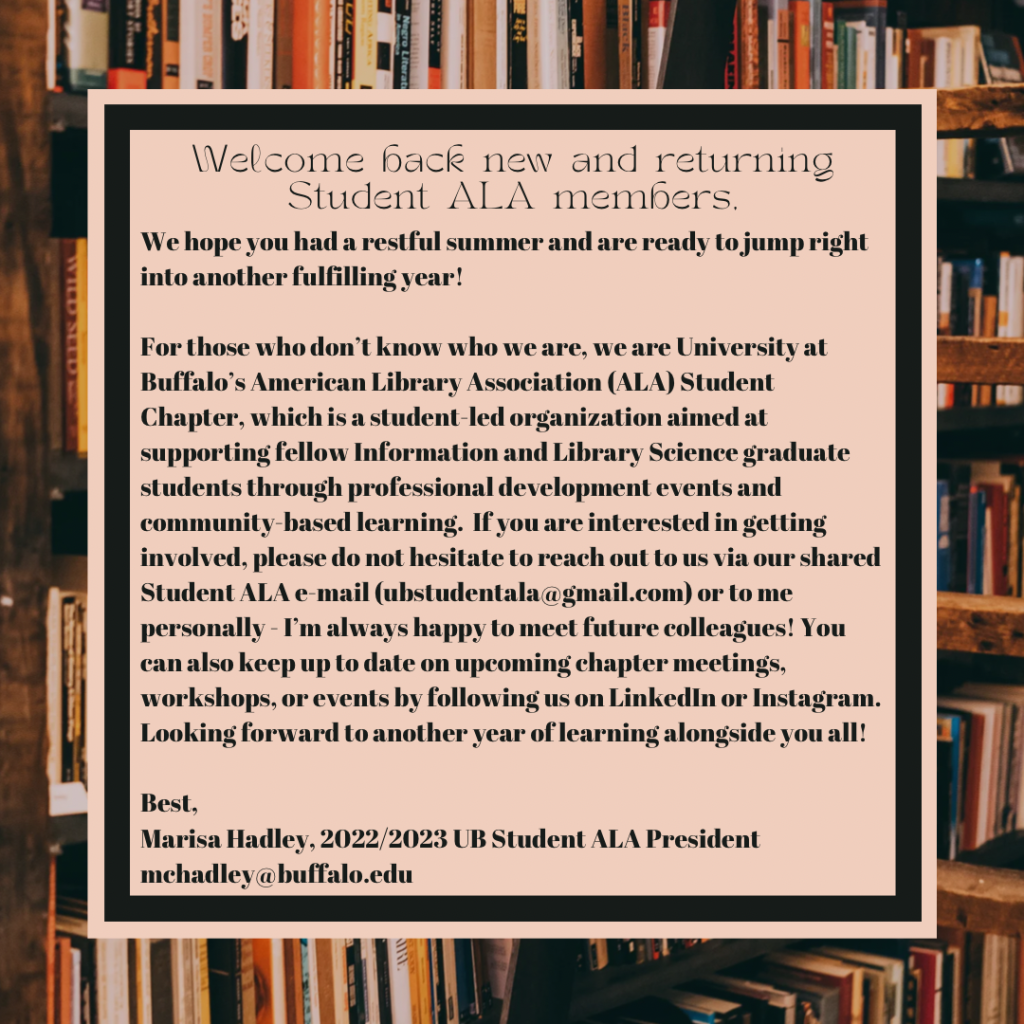
Hello!
Welcome, LIS students! We are the student chapter of the American Library Association of the University at Buffalo. Thanks for visiting our website! After a few years of hiatus, we are back, and we are excited to offer you original programming. Our goal is to provide a way for Library and Information Science students at UB to connect with each other, and to investigate topics that interest all of us. Please let us know if you have ideas for virtual events or future meeting topics, or if you just want to get involved in some way. Every LIS graduate student at UB is eligible to participate – you do NOT have to be an ALA member to participate in our group! Our meeting information will be posted here, but we will meet once per month. We try to alternate between mid-day and evening meetings to accommodate different working schedules, so if this month’s time does not work for you, hopefully next month will. We hope to see you online soon!
-Larissa Brenner, 2021/2022 UB Student ALA President
Talking About Privilege: Reflections from a Workshop on the Subject
By Lisa Buda
I recently attended a workshop offered by my local public library system for staff interested in better understanding the concept of privilege and what it means within our society. The workshop was called Privilege: Taking Out the Sting, Taking in the Reality and was presented by the National Coalition Building Institute of Rochester, NY (NCBI), whose mission is to “educate and nurture leaders who become powerful cross-cultural allies in eliminating prejudice, oppression and other forms of mistreatment” (2016, Mission section). NCBI focuses on providing a respectful space that encourages dialogue within the group to discuss topics that often take people out of their comfort zones.
I was first introduced to the notions of white privilege and institutional racism while taking the Reference Sources and Services course offered by the SUNY University at Buffalo Information Science program. In particular, an article by Brook, Ellenwood, and Lazzaro (2015) stood out in my mind as they discussed institutional racism in academic libraries, a traditionally “white” setting. I later encountered the topic again in an Archival Processing and Description course as archivists have begun to question agency, access, and description in their collections. As a white person myself, I never considered what non-white people could be experiencing in a space traditionally dominated by my own culture and how it could impact their experience within that space. Would a young African-American male be hesitant to approach me at a reference desk in a space dominated by classical architecture? Maybe and maybe not, but these courses got me thinking about the possibility and how other peoples’ life experiences are not my own.
And that’s okay. The workshop discussed these ideas and allowed participants to explore how we see the world but to also be cognizant of other peoples’ perspectives. An example of how this was accomplished was with the showing of a short video they deemed the $100 race. Basically, it brought together a group of kids for a race but with certain advantages given to those who met specific “criteria”. We then paired up and discussed our emotional response, where we placed ourselves within the race, and could the video be related to any other ‘isms” besides racism? This helped to create a dialogue that encouraged active listening so as to listen but also allow each other to be heard. It was encouraging to see people sharing life experiences and perceptions on the topic in an open and respectful manner.
So what does this mean for us in the IS program and as professionals? It means we can put this mindfulness into practice at the reference desk, in describing our collections, thinking about the accessibility and design of our spaces, and even what programming we offer. Be aware of current trends in the field and seek out workshops such as this one to better acclimate yourself to creating positive interactions with your patrons and co-workers. Together, we can work as allies to create safe and welcoming spaces for everyone to enjoy.
References:
Brook, F., Ellenwood, D., Lazzaro, A.E. (2015). In pursuit of antiracist social justice: Denaturalizing whiteness in the academic library. Library Trends, 64(2), 246–284.
National Coalition Building Institute of Rochester, NY. (2016). Retrieved from https://ncbirochester.org/
Peter D. (2017, October 14). Life of Privilege Explained in a $100 Race [Video file]. Retrieved from https://www.youtube.com/watch?v=4K5fbQ1-zps
Welcome to Fall 2019!
Hope you all had a wonderful summer full of adventures. My name is Annie Windholz, and I will be taking over as President of the UB ALA Student organization after serving as Vice President last semester. Previous President Jessica Hollister has graduated– good luck Jessica!
If you have an ALA membership, you can automatically join the UB Student Chapter, just email ubstudentala@gmail.com
This group is 100% student formed and run, and as students we have the power to take this group in whatever direction we want. This semester we are focusing on building up our website’s blog with useful material for all students, regardless if they are an ALA member or not.
I would like to introduce you to Vice President Tom Poehnelt and Media Coordinators Deanna Roberts and Alison Hall. Additionally, our Faculty Advisor is Dr. Brenda Battleson-White (Dr. B). If you are interested in a leadership position, please just let us know. I myself will be graduating this December, so I am looking for someone to take over for me as President at that time.
Thanks and looking forward to getting to know you all this semester!
Annie
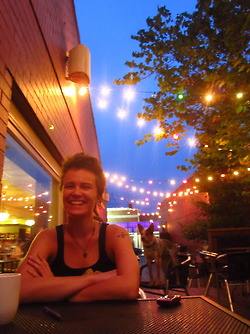
LIS 503 – Costa Rica Excursion
As per Professor Chris Hollister:
As a reminder, we are organizing a non-credit experiential learning trip to explore the libraries of Costa Rica during the week of July 13-20. The trip is associated with this summer’s LIS 503: International Librarianship course. Although LIS 503 students are given preference for this trip, students who do not take the course are also eligible to register, and we still have a few open seats. If you are interested, please email me off-list: cvh2@buffalo.edu.
ALCTS YouTube Webinars
A quick look at ALCTS’s YouTube page, including a review of one video. Reviewed by Lisa Buda.
ALA offers many divisions for professionals looking to join a specialized community within the organization. With an interest in cataloging and metadata, I decided to join the Association for Library Collections & Technical Services (ALCTS). Upon perusing their website, I was delighted to find that ALCTS has a YouTube channel (ALCTSCE) where they post free webinars. YouTube videos are a great resource for students as they are convenient, free, and offer information on a wide range of information science topics and issues.
ALCTSCE has videos that include topics such as preservation, cataloging, and RDA. I decided to focus on the RDA Series Webinars, in particular, the video RDA for Copy Catalogers: The Basics, presented by Vicki Sipe, a Catalog Librarian at the University of Maryland during the time of the video’s recording in 2015.
It’s an hour long video that looks at Resource Description and Access (RDA) concepts and the RDA Toolkit. Some key topics discussed include:
- FRBR and RDA basics
- Option, alternative, and exception rules
- Preference indicators (LC-PCC PS)
- Examples (AACR2 and RDA)
- Helpful bits of information
All of these points were excellent refreshers on items already learned through coursework. The video also provided new information and tips for working with the RDA Toolkit. For example, I never realized that the core elements that are mandatory for a MARC record are designated as such in the toolkit. For example, when one goes to RDA item 2.3.2 “Title Proper”, they will see “CORE ELEMENT” underneath the heading in light blue. Similarly, when an alternative, exception, or option is available for an element, it is shown in green.
The examples Sipe provides are easy to follow and highlight specific points. She also compares AACR2 and RDA records to show their differences and similarities. For example, in AACR2, the “rule of three” applies to creators but this notion is no longer used in RDA, which strives to record as much information as possible.
- RDA prefers spelling out the value rather than using an abbreviation. So “ill.” is now “illustration”. The exception for this is in cases of direct transcription from the source. Such as “Third ed.” should remain as such if that is how it appears on the title page.
- Record more information rather than less.
- RDA encourages the use of the resource as much as possible to extract information. Basically, “use what you see”. But be aware of the preferences your organization may follow. For instance, the Library of Congress-Program for Cooperative Cataloging Policy Statements (LC-PCC PS) may indicate a preference over the documented RDA standard.
- RDA is constantly being reviewed and updated, so be sure to access the most recent resources.
RDA and its accompanying Toolkit encompasses a vast wealth of information and resources. By watching this video, a student can break up key topics into manageable chunks. I look forward to viewing the other videos available on ALCTS’s YouTube channel and hope you will too.
– Lisa Buda, Rochester, NY.